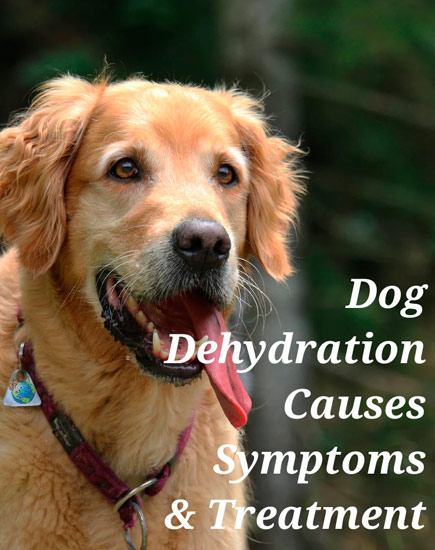Dog Dehydration Causes
| Dog Dehydration Causes | Caution Level | Action to Take |
| Excessive Sweat | 1/5 | Move your dog to a cool and shady spot. Be sure water is available at all times. (Read More) |
| Sickness | 3/5 | Make sure your dog drinks plenty of water. If signs of sickness do not subside, visit your vet. (Read More) |
Dehydration Causes – From Sweat
As the balmy summer months approach, ensuring your dog stays adequately hydrated becomes crucial to prevent dehydration, which can potentially result in organ failure or even fatality. Dehydration occurs when the body, body parts, or organs experience excessive water loss due to fluid deprivation, exposure to heat, or illness. Similar to humans, dogs also sweat when exposed to elevated temperatures.
Sweating is a natural physiological response that helps regulate the body’s core temperature by cooling it down. While sweating is an effective cooling mechanism, it can lead to dehydration in dogs due to the loss of fluids. Therefore, it’s imperative to be attentive to your dog’s hydration needs, particularly during the warmer months, to safeguard against the adverse effects of dehydration.
Dehydration Causes – From Sickness
Illness is another frequent contributor to canine dehydration. When a dog falls ill, its body temperature tends to rise, initiating a cascade of reactions. The elevated temperature prompts the body to exert additional effort, leading to an increased utilization of fluids.
As the body temperature rises, so does the metabolic rate. An escalated metabolism necessitates higher water consumption. In instances where a dog is exhibiting symptoms such as a runny nose, diarrhea, or vomiting, the loss of fluids is further intensified. It becomes crucial to be attentive to these signs of illness in order to address and mitigate the potential risks of dehydration in your canine companion.
Dog Dehydration Symptoms
Identifying symptoms of dehydration in dogs is straightforward as they manifest externally. Observable signs of external dehydration include vomiting, diarrhea, a dry mouth, lethargic or drowsy eyes, a diminished appetite, dark yellow urine, and increased panting. If your dog is vomiting or experiencing diarrhea, these are readily noticeable symptoms. Examine your dog’s mouth for dryness, scrutinize the tongue and the area under the lips, and observe the eyes for any sunken appearance or signs of drowsiness. Additionally, monitor changes in your dog’s eating habits, noting if they are consuming less than their usual amount. Regular vigilance for these external symptoms enables prompt recognition and appropriate intervention to address dehydration in your canine companion.
To examine the color of your dog’s urine and determine if they are dehydrated, take a look at our: Dog Urine Color article. Lastly do you notice your dog panting more than usual? Do they constantly sound out of breath? If any or many of these symptoms appear, your dog could be dehydrated.
Dog Dehydration Treatment
Treatment From Heat/Sweating
Ensure there is a constant supply of fresh water available for your dog. If you have a spacious home or notice that your dog doesn’t regularly feel compelled to drink water, strategically position several water bowls indoors and outdoors. Having multiple water bowls facilitates easier access. For dogs that love to play, consider placing an ice cube in their water bowl. Many dogs find enjoyment in interacting with ice cubes, prompting them to playfully engage with the cube and, in the process, increasing the likelihood of taking a few sips of water. This ensures that your dog stays adequately hydrated, especially during times when they may not instinctively seek out water.
There are hundreds of cute dog bowls available, you can find one that matches your home décor if you would like! Or, if you are a do it yourself kind of person, check out our article on how to make your own dog water feeder.
*A great way to get dogs drinking fluids is freezing chicken broth into ice cubes. Simply pour chicken broth into your ice cube tray and freeze. Your dog will enjoy licking the delicious flavored cubes. Not only will this provide hydration but also essential electrolytes!*
In cases of extreme temperatures, the optimal approach to treat dog dehydration is by keeping your canine companion indoors. While the temptation to engage in outdoor play with your pup may be strong, exercising caution is paramount. It is advisable to allow your dog outside for necessary bathroom breaks and promptly bring them back indoors until the intense heat subsides in your area.
If the weather appears tolerable for your dog to spend some time outdoors, ensure accessible shade is available. Shade provided by a large tree or a canopy offers a suitable spot for your dog to rest and cool down if necessary. It’s advisable to refrain from extended walks and excessive play during such weather conditions to prevent the risk of dehydration and ensure your dog’s well-being.
Take your dog to a water-play area, such as a beach, a park featuring a lake or river, or a backyard with a pool. These locations offer an excellent opportunity to keep your dog cool and reduce the risk of dehydration. Ensure that you choose a pet-friendly beach and park for your dog’s enjoyment. While your dog indulges in water activities, be mindful of anglers or boaters in the vicinity to prevent potential accidents.
Caution is essential when it comes to water sources; dogs should avoid drinking from pools. The chlorine present in pools can lead to skin and digestive issues for your dog. Always provide a nearby bowl of fresh water for your dog to drink. Some dog owners may be uncertain about the safety of allowing their dogs to swim in pools, but as long as there is easy access for them to exit the pool and they refrain from drinking the pool water, it should pose no harm to them.
If you’re on a road trip or camping make sure to keep supplies such as a couple bottles of water available to use as drinking water.
Dog Dehydration Treatment From Sickness
If your dog will drink, but still shows signs of illness you should contact your Veterinarian. If your dog refuses to drink it is recommended to visit your veterinarian immediately.
How to Check for Dog Dehydration
To check if your dog is already dehydrated try the following:
- Check the elasticity of your dog’s skin. Lightly pinch the back of your dog’s neck to see if the skin quickly returns to its normal position. A slow return may indicate dehydration.
- Check your dog’s gums. Hydrated dogs have wet, pink, slobbery gums while dehydrated dogs have dry, sticky gums.
- Assess your dog’s circulatory response time by gently applying pressure to their gums. The area under your finger should briefly turn pale, and upon releasing the pressure, the gums should promptly return to their normal pink or red color within a 2-second timeframe. If the color returns slowly, it may indicate potential circulation issues in your dog, which could be linked to dehydration.
If you suspect your dog is already dehydrated, promptly move them to a cool environment with easy access to water. Avoid allowing your dog to consume excessive water at once to prevent potential vomiting. Take a cold, wet towel and wrap it around your dog’s head and belly. Allow your dog to rest, closely monitoring for additional symptoms like vomiting and excessive panting. If your dog refuses to drink or shows no improvement, it is crucial to consult a veterinarian as soon as possible for professional assistance and guidance.
Enjoy the summer weather with your dogs but remember to have the essentials like water to keep you and your pet safe. It’s easy to go out and enjoy the hot days but preparing before you go out on a walk, a beach day, or a road trip will ensure that everyone has a good time, including your dog!
Dog Lover Store
June 8, 2011
Latest Update: January 1st, 2024

Kim is the co-owner of DogLoverStore with her husband, John. She earned her BS in operations management at the University of Massachusetts Dartmouth. She enjoys walking in nature, gardening in the sun, eating sour candy, going on drives, yoga, and reading.


